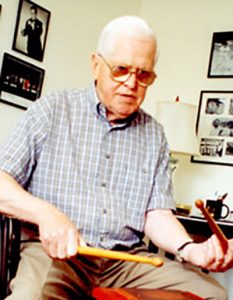PAS Hall of Fame:
Walter Rosenberger
(b. November 2, 1918 - d. July 27, 2013)
by Gordon Gottlieb

Anyone in sports (or any other endeavor) who’s got someone in their life they refer to as “coach” is a fortunate person. It suggests that someone has had a mentor, a guide, an inspiration, a leader, and at the very least, a coach. Walter Rosenberger has several nicknames (Walt, Rosie), but Coach is the one that says it all. The stage crew at the New York Philharmonic referred to him that way, as does his wife, Binny. I’ll get to why later.
Walter Emerson Rosenberger was born November 2, 1918 in Rochester, Pennsylvania. At the age of eight he began studying drums and xylophone, and at age eleven became a member of the Rochester High School Band, marching at football games. He became known locally as “the little drummer boy.”
At age fifteen, while in ninth grade, he was accepted into the Pennsylvania All-State High School Band under the direction of Edwin Franco Goldman. In his high school years he also played drums with a semi-professional dance band, entertaining for proms, DeMolay dances, and so on.
After high school he attended the Juilliard School on a full scholarship, where he studied with Edward Montray and Saul Goodman, and he studied xylophone privately with George Hamilton Green. (Walter’s other teachers include Dave Raegler, Heine Gerlach, Dick Ridgely, and Sonny Galbraith.) During the summer months of his Juilliard years he entertained on marimba at the well-known Valley Ranch near Cody, Wyoming.
After graduating Juilliard, Walter began his professional career playing for two seasons in the Pittsburgh Symphony under music director Fritz Reiner. Before serving in the U.S. Army, he was a free-lance musician in New York City on shows such as Goodyear’s Salute to Youth (an NBC program with Raymond Paige, conductor), The Firestone Radio Show (also NBC), and Morton Downy radio shows with Paige conducting. In 1944 Walter was in the Special Services Division of the U.S. Army, playing drums in a jazz band that toured general hospitals during World War II.
In 1946, after being discharged, he was invited to join the New York Philharmonic, and subsequently served under seven music directors over the course of thirty-nine years. From 1972 until retiring in 1985, he was the principal percussionist of the orchestra. (In 1982 this became the Constance R. Hoguet Friends of the Philharmonic Principal Percussion Chair.)
“Walter had, what was to me, an amazing talent,” says current New York Philharmonic principal percussionist Chris Lamb. “If you mentioned a piece to him he could recall measure numbers and who played what at each measure. When I arrived, I began from scratch, looking at parts sometimes for the first time. If I called Walter he would think for a moment and then say something like, ‘Oh, at measure 48, Buster moves from triangle back to snare, and Arnie steps from cymbals to bass drum, while I go to the xylophone.’ A memory like that I never had nor ever will! I have to keep that kind of information on a little file card, but not Walter. He has it filed away even to this day, I’m sure.”
“The audience, conductor, and even most of the orchestra never appreciate the behind-the-scenes work that goes into organizing a percussion section,” says Rosenberger’s longtime Philharmonic colleague Morris “Arnie” Lang. “Before the first rehearsal, parts have to be assigned, extra players engaged, and stagehands given setup charts. Walter managed that seamlessly and without a hitch. A player’s instruments were listed on the top of each part, and in the course of the part there was a map of each move—much better than MapQuest! Walter never made a mistake. You never heard, ‘Who’s got the triangle at letter A?’
“At one Saturday concert there was an announcement that the next week’s conductor had to cancel, and that a German, Alois Zimmerman, would be the replacement. He changed the program to include his piece ‘Photoptosis,’ but unfortunately, was flying into New York the morning of the first rehearsal with the music. Walter checked his file and found that we had played the piece some seven years before. When Zimmerman walked in with the music, he found the whole percussion section set up—extra players, extra mallet instruments, and even bows for the gongs already on stage.”
A personal highlight for Walter was when he and his section colleagues performed the world premiere of Michael Colgrass’s “Déjà vu for Percussion Quartet and Orchestra” in 1977. The piece went on to win the Pulitzer Prize. Other highlights include recording from live broadcast “Introductions and Goodbyes” of Lucas Foss, conducted by Leonard Bernstein, with Walter featured on xylophone, along with the legendary Young People’s Concerts, Promenades, Rug Concerts, Prospective Encounters, and Horizon Concerts.
“It is evident, by the thousands of concerts, hundreds of recordings and TV shows, that Walter was the consummate orchestral mallet player,” says Lang. “It is not well known that he sustained serious injury in an auto accident when he was in his early twenties—injuries that continued to affect him his whole life. Some days, at rehearsal, I would watch him from the corner of my eye and wonder how he would be able to play because his hands were shaking so badly. But he almost never hit a wrong note! On those rare occasions the whole section would shuffle its feet, which would just get him angrier at himself.
“Aside from his mallet prowess, he was a great bass drum player. Some years ago I was in a Tower Records store and a CD was playing. I was barely listening until I heard the most beautiful bass drum note: one note. The CD was Mahler ‘Symphony #2.’ I inquired at the desk what orchestra was playing and was told it was the Columbia Symphony with Bruno Walter conducting. I was so sure of that one bass drum note that I inquired at the New York Philharmonic archive. It turned out that Columbia had mislabeled the CD release and it was the New York Philharmonic playing. I knew it was Walter playing that one note!”
During his years in the New York Philharmonic, Walter also played with radio, TV, and recording orchestras. As an original member of the Sauter-Finegan Orchestra (1951–52), he performed the opening drum solo for the orchestra’s first recording, “Doodletown Fifers,” which became its theme song.
As a teacher, beginning in the 1940s Walter was head of the percussion department at the Mannes College of Music. He also taught at the Manhattan School of Music, and after retiring from the Philharmonic, he taught at the Juilliard School for several years.
“Not the least important achievement while a member of the New York Philharmonic,” Walter said, “I was founder, player-manager, and coach of the New York Philharmonic softball team from 1967–1985.” That team, the Philharmonic Penguins, often would play teams on tours all over the world. The bats, balls, and bases were even transported in the percussion trunks.
“When I auditioned and won the position for principal percussion,” says Lamb, “Walter’s first question after the audition was, ‘Can you play softball?’ He was not only ‘Coach’ or ‘Rosie’ but sometimes he was referred to by the stage crew as ‘Mother’ because of the care he took in organizing all of the percussion logistics for all the additional players sometimes hired for larger works.”
I can personally speak to “Coach’s” baseball/softball savvy, having participated in some of these games. He was a fine pitcher and hitter, and could fire up that team like an evangelist minister on his congregation—but always with his trademark sense of humor. That’s the key to Walter: his grace. And speaking of trademarks, I loved the way his head and neck would bob and weave while he played the xylophone. Along with his precision (another trademark), he always saw to it that he was having fun as well.
I’m still laughing inside when I think about some of the stories Walter used to tell (particularly the Philharmonic-on-tour stories). He’d crack up as much as any of us who were listening, which was part of his charm and charisma.
Happily, much of Walter’s legacy can be found in the boatload of recordings done by the New York Philharmonic, mainly with Leonard Bernstein. There are DVDs of the Young People’s Concerts, and CDs of most of the standard repertoire. Any percussionist who wants to learn how to play “Porgy and Bess,” Schuman’s “Third Symphony,” or “Appalachian Spring” need only listen and watch. Let Walter be your coach.
It is moving and fitting that Walter, at age 92, will be joining all of his colleagues—Saul Goodman, Elden “Buster” Bailey, and Morris “Arnie” Lang—into the PAS Hall of Fame. This legendary group of musicians should be, and will be, eternally linked. It was an honor to nominate Walter for inclusion in the Hall, and I’d like to thank my co-nominators: Alan Abel, Vic Firth, Arnie Lang, Tony Cirone, Chris Lamb, Dan Druckman, Jim Ross, and Jim Petercsak.









